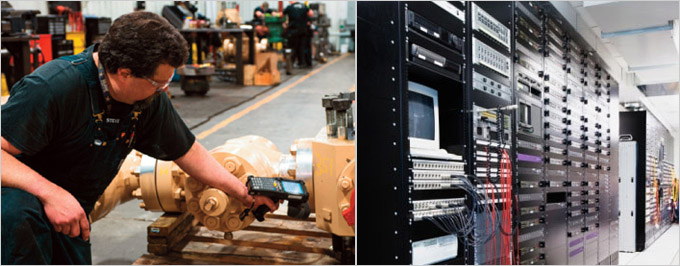 Sendtime 2020-01-19
Sendtime 2020-01-19 BY
BY  Read 908
Read 908The assets of enterprises or government administrative institutions are mainly vehicles, office equipment, intangible assets, servers, computers, office furniture and other equipment. The current asset management mainly adopts the asset management system of the financial system, which cannot realize the reasonable and scientific management of real assets.
 Ii. Existing problems
Ii. Existing problems
1. Asset management lags behind
Asset inventory is an indispensable and important link in asset management, which plays a role in checking and reflecting the status of assets in physical accounts, as well as in on-site verification and supervision.At present, most enterprises still completely rely on manual inventory taking, with lagging management methods, low inventory efficiency and accuracy, and a lot of repetitive work.
Later data statistics and report making are heavy, and the whole inventory cycle is long.Often, the assets have not been accounted for, and some assets have been changed or purchased.During the use of assets, the management personnel can only manage the assets theoretically through the system, and the actual use status and status of assets cannot be timely and accurate feedback.
2. Incomplete asset management responsibility system
Since there is no responsibility for asset management, it is common for employees to use the assets for the purpose of use, without caring who is responsible for the custody of the assets. The actual situation of the assets that each employee is responsible for is not clear.The imperfection of asset management responsibility system directly leads to low utilization rate of assets, which easily leads to repeated purchase and loss of assets.
3. Dispersed assets are difficult to manage
The large amount of assets, geographical dispersion, inaccurate and timely information makes it difficult for managers or business personnel to timely understand the status of assets, such as quantity, components, storage location, using enterprises, using departments, responsible persons, use status, etc.
4. Real-time supervision cannot be realized
The management personnel and responsible personnel are unable to query the current actual state of assets in real time, and cannot quickly carry out budget approval, business approval, leadership decision-making and other work.

Iii.The necessity of strengthening the management of fixed assets
1. It is necessary to ensure the sustainable and healthy development of the enterprise
As an important part of enterprise assets, fixed assets and low-value consumables are the top priority in enterprise financial management, and also the most complicated part of enterprise management that consumes the most human and material resources.Due to the high value of fixed assets, long use cycle, scattered use location and other characteristics, it is difficult to achieve one-to-one correspondence of accounts, CARDS and things in the actual work, which brings certain difficulties to the use, supervision, change, replacement, maintenance, loss, inventory, cleaning and other work.It also has a direct or indirect impact on the data statement statistics, asset structure analysis, asset evaluation and enterprise listing and reorganization, and plays a decisive role in the development of enterprises.
2. It is an inevitable requirement to adapt to the rapid development of enterprises
Along with the increase in unit size, number of assets and personnel, the existing fixed assets management mode is far lagging behind the needs of the development of enterprises or government administrative institutions, introduce advanced management mode of fixed assets, fixed assets for efficient and accurate management, become the inevitable requirement of healthy and rapid development of enterprises.
 Iv. Program objectives
Iv. Program objectives
1. Classified management of assets
Scientific unified classification of assets is a very important first step and foundation in the asset management of administrative enterprises and institutions.The state has issued relevant standards for the classification of fixed assets, which is more conducive to the connection with financial or other systems.
2. Responsibility for asset management lies with people
The ownership of the internal assets of an enterprise is the enterprise, while the use of the assets is everywhere in the enterprise, involving every employee of the enterprise. It is difficult to manage such a large number and such a wide distribution of assets only by a few asset managers.In the work of asset management, the work of asset management should not only be regarded as the responsibility of a department or several people, but also the responsibility of asset management should be transferred to people. Every staff member should always know the status of assets they use and keep, so as to realize the full staff management of assets.
3. Real-time grasp of asset usage
For the assets in use, all the information occurring in the whole life cycle should be recorded, so as to realize real-time and dynamic grasp of the use of assets in a simple and feasible way, so as to facilitate the maintenance, annual inspection and reasonable allocation of assets and avoid waste.
4. Realize convenient and quick inventory
In the process of fixed assets management, inventory is a very important link.It is necessary to change the previous manual inventory method with low efficiency and high error rate, and use modern management methods and management methods to realize efficient and fast modern inventory and reduce inventory cost as far as possible.In the inventory process, the administrator should grasp the information of assets comprehensively and clearly, and sort out the inventory data through statistics.Through further analysis of the inventory data, the product quality and repair probability of the assets can be understood to provide reference and basis for improving the structure of the assets.
5. Smooth connection of financial system
Asset management system and financial system to achieve smooth data docking, to achieve the mutual import and export of data between the two systems.And can query a variety of statistical statements.Statements can reflect the statistical data of assets and provide managers with macro data information of asset management. Meanwhile, statements are also the basis for the reconciliation between managers of fixed assets and financial personnel.
With the increasing expansion of business and scale, as well as the continuous improvement of management level, the use of scientific and advanced fixed assets management methods and systems, the development of administrative undertakings, enterprises and units has a very important impact.
RFID asset management system is a set of professional asset management system, adopted by far the most advanced and practical automatic identification technology (RFID) to collect data, support the RFID electronic tag identification as an asset, the system has greatly improve the efficiency of the assets management department, get rid of the heavy manual work, implements the assets of the entire life cycle of operations management.The system is different from the past mainly on financial management of fixed assets management system, RFID asset management system on the basis of full investigation and study, adopting workflow management, realize the purchase of assets, borrowing, loading and unloading related functions such as inventory, and tracking the usage of assets, the whole life cycle, offers a variety of reports to the use of assets, the circulation situation, depreciation in multi-angle analysis, demand statistics made to support the asset management of the enterprise, at the same time provides the related content of financial system integration.

V. Asset benefit analysis
According to the survey conducted by international data corporation (IDC) on a number of multinational enterprises in the global fortune 500 and China, an effective and perfect fixed asset management solution can help enterprises solve:
♦Reduce audit costs by 75%;
♦A 45% reduction in equipment "missing";
♦Reduce equipment downtime by 50%;
♦Reduce spare parts inventory by 40%;
♦Increase asset utilization by 30%;
♦Extend the operating life of equipment by 10%.
 Relate recommen
Relate recommen

Tel:010-84048366
Email:gracewitark@gmail.com 
Add:shenzhou-great wall building, no.2 yard, shimen middle road, chaoyang district, Beijing
Scan watching us